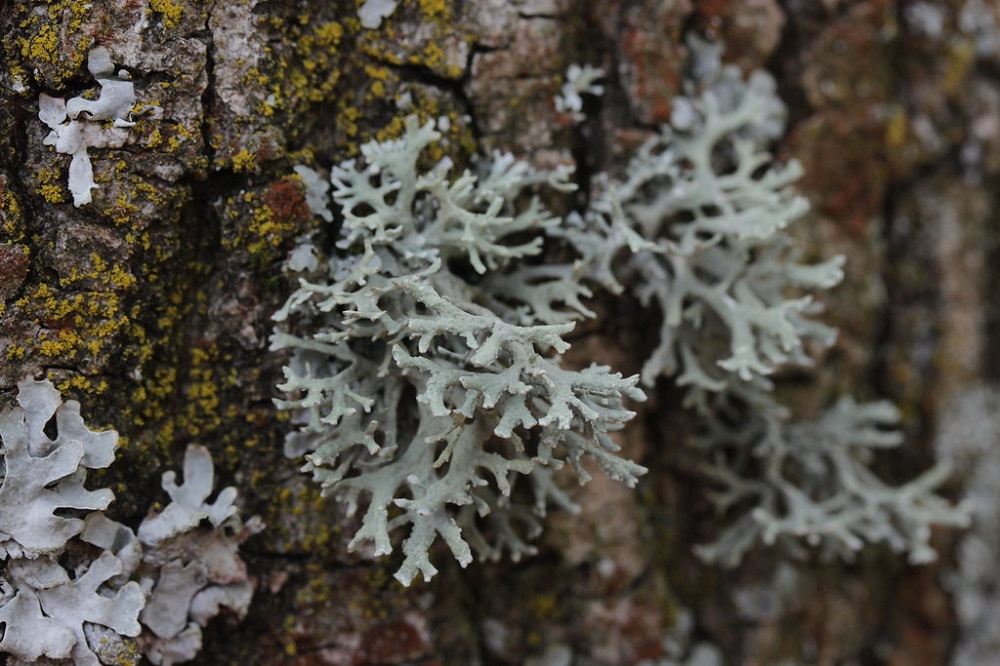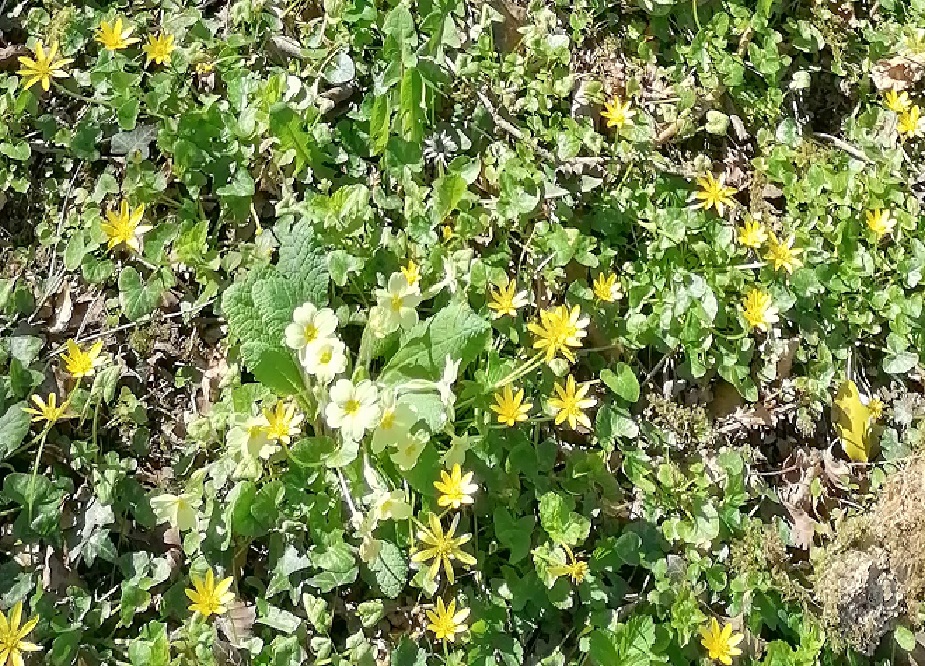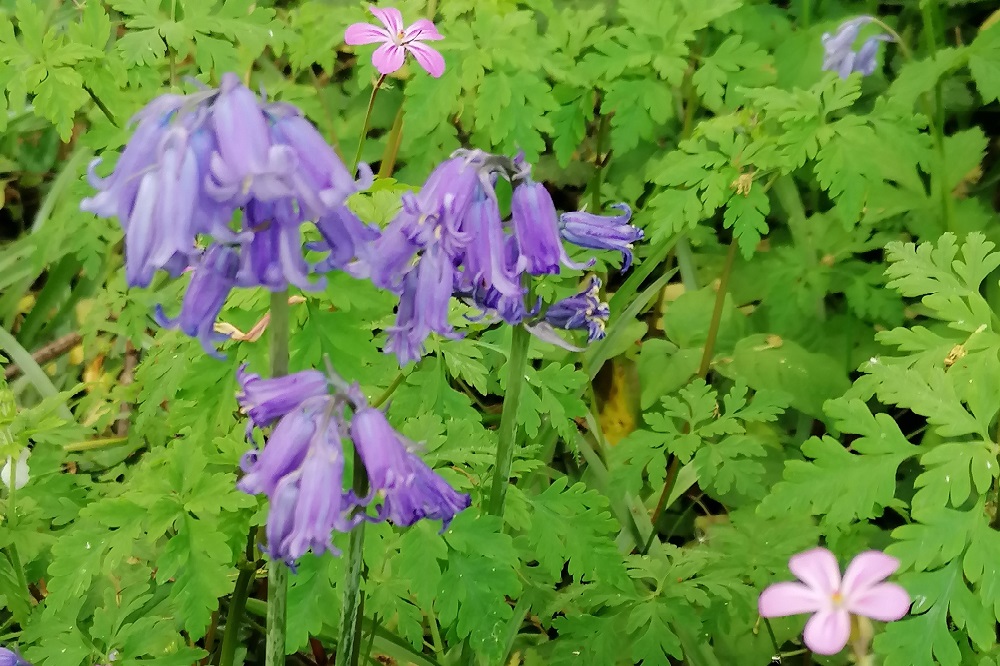Cynefin – A Sense of Place: Gog and Magog part two

Gaynor Funnell
I focus on the apparent bareness of Magog, and notice that the small horizontal limb attached to her remaining standing trunk is scattered with tufts the colour of a new penny. They look like new leaves emerging, which maybe a small thing, but it may mean that Magog isn’t dead at all.
It’s a trek to find out – too steep to go as the crow flies – so the only option is to go back up the track, and walk down the other side. This is nearly as steep, with over-hanging branches of hawthorn and hazel which catch in my hair, and my feet slip as I tread amongst twigs and leaves, the fallen memories of last year’s summer.
The emerging leaves of lesser celandines, which are invisible from my usual viewpoint, are also surprisingly slippery. Their flowers are beginning to open, their petals reflexing back on themselves, which, according to folklore, means it isn’t going to rain.
I love celandines and don’t see them as weeds, as some do. Their buttercup-satin petals, a bright yellow with just a hint of green, glow in the sunlight, illuminating the ground.
Higher up the bank, the apple-green trefoil leaves and the white veined-with-lilac bells of wood sorrel, or crinche cranche, rise amongst the moss growing on fallen branches.
The flowers have a luminous quality against the dark of the floor of the wood and the bitter, lemon-zest tasting leaves make my mouth tingle as I nibble a heart-shaped corner.
The leaves shut down at night and according to folklore are apparently eaten by cuckoos to clear their voices.

Meanders
There’s a small stream at the bottom of the slope. It meanders through boulders and rocks, some shot through with crystal, some smooth and cool to the touch, others craggy, with chunks gouged out of them, searching for the easiest way to reach the bottom of the cwm, which is what all watercourses do.
In early summer, curls of scaly male fern unravel casting a feathery shadow over its surface whilst harts tongue ferns absorb as much moisture as they can.
The stream runs through drifts of pungent wild garlic, through primrosed banks, slips under the boughs of alder, willow and hazel, puddles with ragged robin and flag iris and marsh marigold before joining Nant Ceibwr, on its never-ending quest to find the sea.
Today, the stream is calm. It burbles and trickles, lying silently in pools of darkness in the hush of the wood, collecting in hollows created by fallen branches, where tiny insects circle aimlessly in the air above it, circle again and again like dust motes caught in the sun, and where the brown-green secret smell of a wood lies heavy.
The stream can disappear in a dry summer, leaving a pale, rocky path, the normally unseen bed exposed, the rocks drying and fading, but can torrent with gallons of frothing, churning, muddy water following days of rain.
Shadowing the course of the stream, the lime-green leaves of the golden saxifrage that highlight the shade of the path feel soft and springy under my feet.
The plant vies with the similarly coloured moschatel, whose flowers on top of a miniature periscope-stem give it the name of the townhall clock plant.

Origami petals
I jump across the narrowest part of the ditch and head up the other side of the slope, which is dominated by the cathedral-quiet of a huge beech tree, the so-called queen of the forest.
She has a solid pillar of smooth grey trunk soaring into arms that spread and arch over the width of the path and beyond, and the emerging leaves have a wonderfully diffuse bright-green freshness, which flicker and dance with the sunlight.
As yet the cover isn’t strong enough to shade the ground, which is ankle deep in dry, brown leaves and the husks of empty beech masts, open like beige, origami petals, which rustle as I walk through them.
Further along, the path winds and dips through purple-blue billows of bluebells, which occupy the liminal space between wood and field and spread as far as the eye can see.
Blue upon blue upon blue – a sign of an ancient woodland. It’s hard not to stand on any of the plants, but when you do, there’s a slight give, a slight crunch – the stem of a bluebell is hollow and filled with sap, which was once used to bind pages onto the spines of books.
A faint smell of hyacinth drifts as I continue walking, and when I turn the corner, a patch of white gleams amongst the twisted roots of Gog.
It’s a small clump of white bluebells, which have the effect of making the blue ones more blue somehow. They are dainty and delicately pretty, and are probably quite rare, but for me, nothing is more beautiful than a blue one.
Moss
Further along the track is a badgers set. I don’t walk down to it too often as I don’t want to disturb them, but occasionally see them in the fields where they’re digging for worms.
They can move surprisingly fast when disturbed, a rippling run of black and white. They make a cacophony of noises – churrs, purrs, wails, chitters, snorts and yelps amongst others, which sound terrifying at night.
I turn downwards and half walk, half slide to reach Magog. The moss still clinging to its branches is dry to the touch, dry where it should be moist and springy.
I have no idea if it’s dead.
Moss seems to grow on everything in this damp Welsh valley. I imagine, if I stood here long enough, it would soon grow on me.
Whereas moss tends to grow on the shady side of a tree, lichen prefers the sunny side and only grow where the air contains few pollutants.
The lichen on Magog is the same colour as reindeer moss, a silvery sage, and looks like antlers on a deer with a few extra tendrils. It’s abundant on most of the trees here, I can see it on Gog, on hawthorn, on blackthorn. It’s called Evernia prunastri or oakmoss, and its musky, woody scent is why it’s used in making perfume.
Lichens are supposedly indicators of clean air and only grow a couple of millimetres a year, so some of them here must be years old.
From what I’ve seen since living here, this wood – which covers about 20 acres and spreads through the north and eastern side of the farm – maybe a remnant of a Celtic rainforest. Such habitats can be found along the western coastline of Wales, Scotland and England and are now fragmented and rare as a result of tree clearance and over-grazing.
The plant indicators of this type of habitat are Polypody ferns, mosses, lichens and epiphytes – plants that grow on other trees due to the damp and humid conditions – and those abound here. Little islands of moss and fern on a sea of oak.
Magic
Standing amongst the trees, it’s easy to see why there are so many myths and legends associated with them; the holy groves and walking place of the gods, inhabited with dryads, nymphs and centaurs.
There is that sense of mystery, of magic about them, combined with the feeling they’ve been there for ever. Mixed with the haunting sense that one day they might not be, that time is running out for many woodlands.
There’s something behind the remains of Magog, which I hadn’t been able to see from the deck. About twelve feet tall, it’s a young Magog, with a grey striated trunk and rose-gold drops of leaves clasping thin branches.
The sapling is leaning to the right, presumably so it could capture the maximum amount of light, as the bulk of the older tree would have blocked much of it out.
Now Magog is no longer standing, it means this younger version will thrive. The pattern of regeneration in the world of the wood.
I sit on one of Magog’s fallen branches and place a hand on the wood. It’s rough, pitted, dry, and already the bark is beginning to lift in a few places – it’s becoming a home for new insects.
The earthy smell of years of death and regrowth rises from where my feet have disturbed the ground, ground normally tracked by foxes, badgers, the occasional rabbit.
I look up at the jagged remains of the trunk, standing ten foot or so, piercing the air. It really did split like a matchstick. But growing on one side, the same colour as the new oak sapling, a ruff of leaves is stretching outwards, feeling for life.
Gaynor Funnell is the winner of the Nigel Jenkins award for 2022. We are delighted to be publishing a series about Penbanc over the coming months, with support from the H’mm Foundation.
You can read part one and two of the serialisation here
Support our Nation today
For the price of a cup of coffee a month you can help us create an independent, not-for-profit, national news service for the people of Wales, by the people of Wales.




